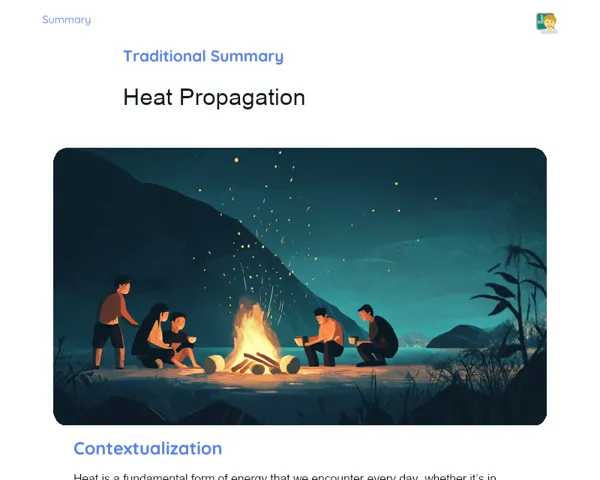Summary Tradisional | Chemical Bonds: Ionic and Covalent
Contextualization
Chemical bonds are like the superglue for atoms, holding them together to form everything from water to salt and even the air we breathe. Without these bonds, nothing would exist as we know it. Grasping the concept of chemical bonds helps us understand what materials are made of and how they react with one another.
There are two primary types of chemical bonds: ionic and covalent. Ionic bonds happen when atoms swap electrons, resulting in positively and negatively charged ions that stick together. These bonds typically form between metals and non-metals. On the flip side, covalent bonds arise when two non-metal atoms share their electrons to become stable. Both types of bonds have unique features that impact the physical and chemical behaviours of the resulting materials.
To Remember!
Ionic Bonds
Ionic bonds occur when atoms transfer electrons, leading to the creation of ions. This bond is usually seen between metals and non-metals. In these cases, metal atoms tend to lose electrons, turning into cations (positively charged), while non-metal atoms gain electrons, becoming anions (negatively charged). The oppositely charged ions attract each other, forming a stable ionic bond.
A well-known example of an ionic bond is sodium chloride (NaCl), or table salt. Sodium (Na) gives up an electron to chlorine (Cl), resulting in Na+ and Cl- ions. The strong attraction between these ions causes them to arrange into a crystalline structure.
Ionic compounds are known for having high melting and boiling points because of the strong forces holding the ions together. Additionally, these compounds can conduct electricity when dissolved in water, as the freed ions move around to carry the electric current.
-
Form between metals and non-metals.
-
Involve the transfer of electrons.
-
Create ions that attract each other electrostatically.
-
Example: NaCl (sodium chloride).
Covalent Bonds
Covalent bonds occur when two non-metal atoms share pairs of electrons in order to become stable. For each shared pair, both atoms contribute at least one electron, forming a bond that holds them together.
A common example of a covalent bond is the water molecule (H2O). Here, oxygen shares electrons with two hydrogen atoms, which results in two covalent bonds. This sharing allows the atoms to achieve a more stable electronic arrangement.
Covalent bonds lead to compounds with diverse properties. Unlike ionic compounds, covalent substances can have varying melting and boiling points, influenced by the strength of the forces holding the molecules together. Typically, covalent compounds don’t conduct electricity, as they lack free ions.
-
Form between non-metals.
-
Involve sharing pairs of electrons.
-
Result in molecules with various properties.
-
Example: H2O (water).
Characteristics of Ionic Bonds
Ionic bonds have distinct features that affect the properties of the compounds formed. The creation of cations and anions leads to the formation of well-organised crystalline structures, which account for the high melting and boiling points of ionic compounds. A lot of energy is required to break these ionic bonds.
Solubility in water is another key characteristic. When ionic compounds dissolve in water, the ions separate and move freely, allowing electricity to pass through. This property is useful in many applications, like in batteries.
Generally, ionic compounds are hard and brittle. Their rigid crystalline lattice structure makes them resistant to changes in shape, but hitting them with enough force can still cause them to break apart.
-
Form ordered crystalline structures.
-
Have high melting and boiling points.
-
Dissolve in water and conduct electricity.
-
Tend to be hard and brittle.
Characteristics of Covalent Bonds
Covalent bonds lead to compounds with a wide range of properties. One of their key traits is that they form distinct molecules instead of crystalline patterns. This means the physical properties of covalent compounds can differ significantly based on intermolecular forces.
Covalent compounds can show low or high melting and boiling points. Smaller, non-polar molecules usually have lower points, while larger or polar molecules often have higher ones due to stronger interactions.
Covalent compounds generally have low electrical conductivity because they lack free ions. However, some covalent compounds, like acids, can conduct electricity when dissolved in water due to partial ion formation.
-
Form distinct, individual molecules.
-
Display varied melting and boiling points.
-
Exhibit low electrical conductivity.
-
Properties depend on the strength of intermolecular forces.
Key Terms
-
Chemical Bonds: Forces that hold atoms together to create molecules and compounds.
-
Ionic Bonds: Bonds formed due to electron transfer between metals and non-metals.
-
Covalent Bonds: Bonds created through the sharing of electron pairs between non-metals.
-
Ions: Charged atoms formed by losing or gaining electrons.
-
Cations: Positive ions formed by electron loss.
-
Anions: Negative ions formed by electron gain.
-
Ionic Crystals: Ordered structures created by ions in ionic compounds.
-
Electron Sharing: A feature of covalent bonds where atoms share pairs of electrons.
-
Physical Properties: Characteristics such as melting point, boiling point, and ability to conduct electricity.
-
Chemical Properties: The behaviour of compounds during chemical reactions.
Important Conclusions
Chemical bonds are crucial to the existence of all matter, bringing atoms together to create molecules and compounds. In this lesson, we've delved into the two key types of chemical bonds: ionic and covalent. Ionic bonds involve the transfer of electrons between metals and non-metals to form ions that attract each other, whereas covalent bonds occur between non-metals, where electron pairs are shared for stability.
Recognising the characteristics and differences between ionic and covalent bonds is essential for understanding how these forces shape the physical and chemical properties of compounds. For instance, ionic compounds like NaCl boast high melting and boiling points and are excellent electrical conductors when dissolved in water. Conversely, covalent compounds such as water (H2O) consist of distinct molecules with variable properties and generally do not conduct electricity.
This understanding is vital not only for comprehending material composition but also for its practical applications in various fields, including medicine, engineering, and biology. We're excited to encourage all learners to keep exploring this topic, as a solid grasp of chemical bonds can help us manipulate materials and compounds in new and innovative ways.
Study Tips
-
Review the examples of ionic and covalent bonds discussed in class, like NaCl and H2O, and try to find other examples in your day-to-day life.
-
Work through exercises that involve recognising chemical bonds in different compounds to reinforce your grasp of the characteristics and differences between them.
-
Utilize diagrams and comparison tables to better visualise the properties of ionic and covalent compounds, aiding your understanding and memorisation of the concepts.


